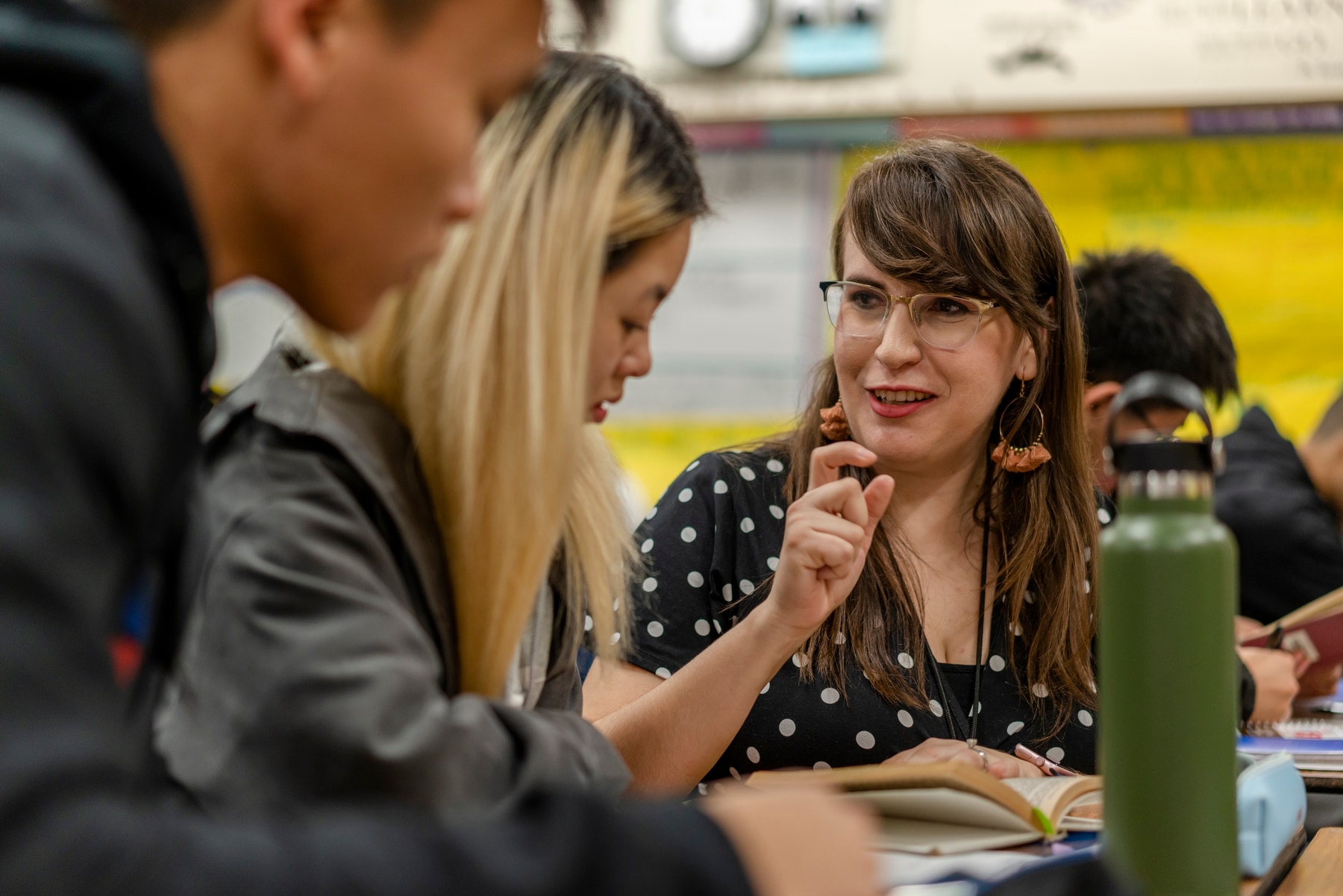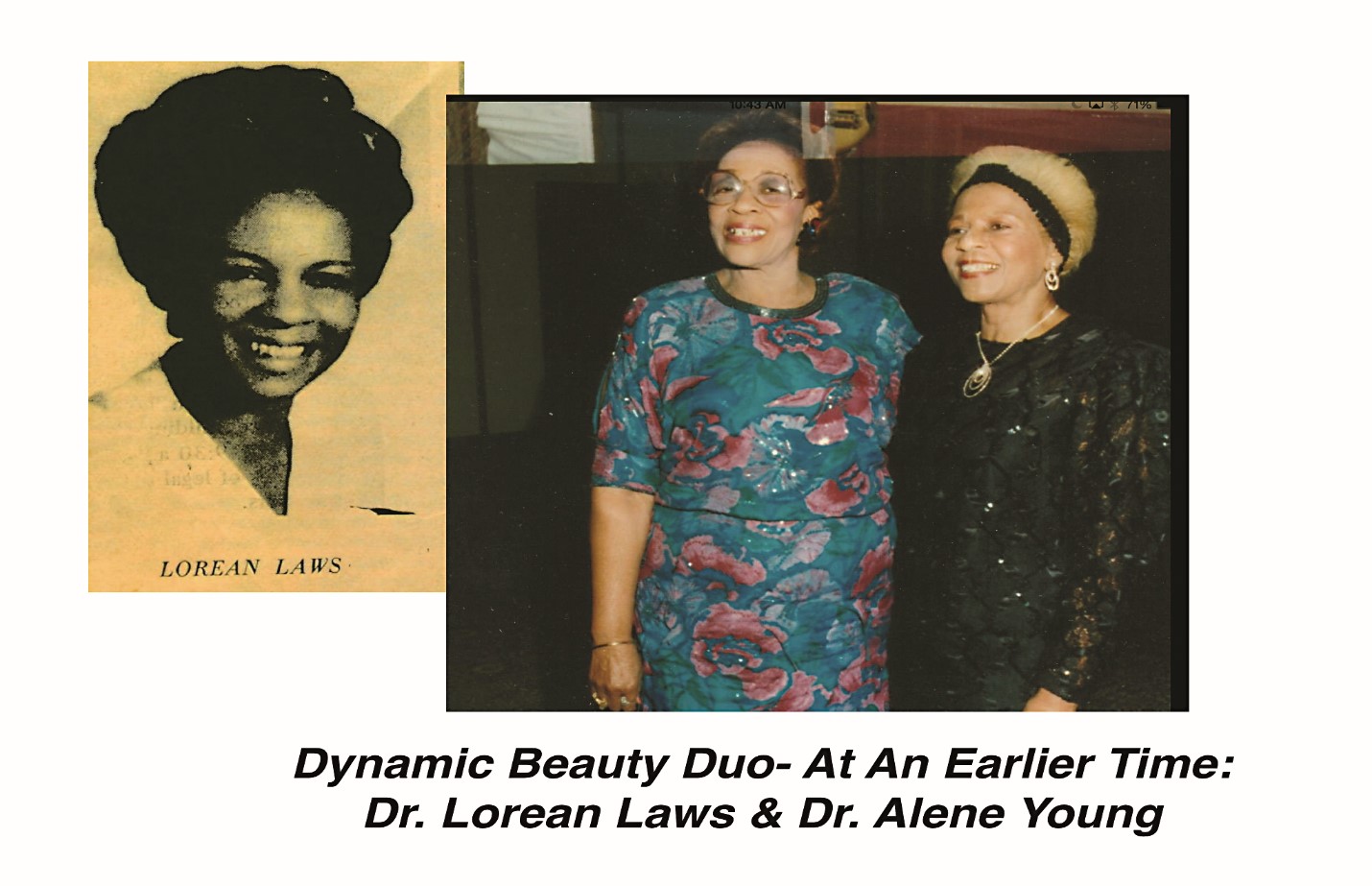
By Laura Meckler and Kate Rabinowitz
Ricardo Alcalá’s parents, born in Mexico, carried less than a second-grade education when they came to California to work the fields. His older siblings dropped out of high school. One was sentenced to prison for life and killed behind bars. Ricardo was 13 then, living in poverty.
But when he was 14, something changed. A Latina teacher told him he was too smart for pre-algebra and should move up.
“For some reason, that simple act and belief changed my entire perception of schooling, and life really,” he said. “She was the first person who saw something good in me.”
Now, Alcalá is a high school Spanish teacher, looking for the good in his students, most from Latino and poor families like his. He nudges boys drawn to gangs toward the wrestling team instead, and serves Mexican hot chocolate on a Monday afternoon, hoping that small treat will dissuade students from skipping class.
Not many teachers at Elsie Allen High School can connect with students in the same way. While 80 percent of students are Latino, just two of 56 teachers are — 3.5 percent.
Nationally, a Washington Post analysis of school district data from 46 states and the District of Columbia finds that only one-tenth of 1 percent of Latino students attend a school system where the portion of Latino teachers equals or exceeds the percentage of Latino students.
It’s only marginally better for black students: 7 percent were enrolled in a district where the share of black teachers matches or exceeds that for students. Among Asian students, it was 4.5 percent.
Meanwhile, 99.7 percent of white students attended a district where the faculty was as white as the student body, The Post found.
In nearly all U.S. school districts, students of color outpace teachers of color
Below shows the proportion of teachers and students of color for U.S. school districts. Circles are sized to the number of all students. The teacher of color gap is the percentage of students of color less the percentage of teachers of color. The larger the gap, the less diverse the teacher population is compared with the student population.
Over time, the ranks of teachers of color have grown. In 1988, 87 percent of public school teachers were white. By 2016, 80 percent were, according to federal data.
Nonetheless, the racial gap between teachers and students has widened as more young people of color have enrolled each year. In 1994, two-thirds of public school students were white; by 2016, fewer than half were.
Some of the challenge is demographic: Latinos are younger, as a group, so they make up a greater share of the student population than the adult population. Teachers may stay in the profession for decades, so it takes time for the workforce to transform.
They are less likely to go to college, less likely to enroll in teacher preparation programs, less likely to graduate and less likely to be certified as teachers, the Education Department found in a 2016 report.
And yet researchers have found significant positive results when black and Hispanic students have teachers who match their race or ethnicity: better attendance, fewer suspensions, more positive attitudes, and higher test scores, graduation rates and college attendance. Teachers of color also have higher expectations for students of color, which may fuel the other gains.
“Representation absolutely matters and it matters for … almost every educational outcome you can think of,” said Seth Gershenson, a public policy professor at American University.

Michael Waters, principal of Wright Charter School in Santa Rosa, Calif., says recruiting Latino faculty is challenging, but students, such as Andrea Chavez, still get a great education. “There’s so much love given to these kids,” he said. The school district had one Latino teacher last year. (Chris Hardy for The Washington Post)
A demographic mismatch
The power of these connections is apparent here in Sonoma County, a liberal part of America north of San Francisco. It is home to rugged California coastline, stunning vistas and some 425 wineries — but also poverty. Forty-five percent of students in the county are Latino. Latino teachers are far more scarce.
In the Roseland School District in Santa Rosa, 92 percent of students last year were Latino, but just 14 percent of teachers were. That’s a gap of 78 percentage points, one of the biggest in the country, The Post found.
In the neighboring Wright Elementary School District, nearly two-thirds of students last year were Latino. There was one Latino teacher.
Celio Batres, 17, a senior at Roseland Collegiate Prep whose family emigrated from El Salvador, recalled an assignment to explore different cultures and feeling like he couldn’t connect with his white teacher. “She grew up in a middle-class family, basically living the American Dream, and that’s completely different from my family and the way we were brought up,” he said.
He said it was different with the one Latino teacher he had. Tomas Salinas talked about his own home growing up, the aroma of food wafting from the kitchen where his mom was cooking. “My house, it’s the same way,” Batres said.
A classmate, Sebastien Jean, 17, who is black and Hispanic, remembers that his elementary school teachers were all white, so he started acting what felt like white, absorbing what he called the “Caucasianness of it.”
“I sort of lost my flavor,” he said.
That created tension with his mother. “I would go home and start talking about the weather and gas prices and my mom would be like, ‘Where did you get that from?’ ”
It was different with Mr. Salinas. “He treats us like we’re his children.”

After years in classrooms led by white teachers, students at Roseland Collegiate Prep found they could better relate to English teacher Tomas Salinas. “He treats us like we’re his children,” one student said. (Chris Hardy for The Washington Post)
Salinas, whose parents are Mexican, remembers being on the other side. A Latina teacher hung Mexican and American flags in his fourth-grade classroom, not far from where he teaches today. “That just spoke to me as a kid,” he said. Now, as an English teacher, he incorporates Latino authors into his course.
But being one of the only Latino teachers isn’t easy. He remembers his first day at his job, when staff were gathering in the gymnasium. He found himself standing by another Latino man — a custodian. “I remember thinking I should go sit with other [teachers], but that was my comfort zone,” he said.
Leaders of the Wright and Roseland districts said their priority is finding the best teachers available. Hispanic teachers are hard to find, they said.
“It would be lucky and wonderful if they were [Hispanic], but we need the best of the best,” said Amy Jones-Kerr, superintendent of the Roseland district.
“You don’t want all of your Hispanic kids looking up to a bunch of white teachers and that’s basically what we have so, yeah, it’s an issue,” said Adam Schaible, superintendent of the neighboring Wright district. “It’s not a front-burner issue for me or for my district. I think in the hiring process, we are always giving preference to people who are bilingual, bilingual Spanish. There aren’t that many of them.”
Schaible said he has tried to find Latino aides or other paraprofessionals for a countywide teacher-training program aimed at recruiting Latino teachers. But he said he hasn’t found anyone to recommend, partly because a bachelor’s degree is required to participate.
The demographics are similar in the county’s largest district, the Santa Rosa City Schools. Superintendent Diann Kitamura said she thinks about the problem every day.
She said she is looking for teachers through wider advertising, attending more job fairs, making sure all their materials are in Spanish as well as English, even staffing a booth at a summer farmers market in town. She applied for a grant to recruit teachers from Mexico and Spain.
Creating a more diverse workforce is a long-term proposition. In the meantime, she says she’s doing what she can to boost Latino achievement. After considerable debate, the school board changed a policy that had funneled many Latino students into an academic program that is not rigorous enough to qualify students to attend state universities, even if they receive perfect grades. Under the new policy, most students are put into the college prep sequence.
Santa Rosa also changed school board elections, with members now chosen to represent districts within the city, rather than being elected at-large. The resulting board is now far more diverse.
And Kitamura is looking at balancing teaching assignments between the more affluent east side of town vs. the more heavily Latino west side.
“The west always has the newbies,” she said.

Ricardo Alcalá is one of two Latino teachers at Elsie Allen High School in Santa Rosa. (Chris Hardy for The Washington Post)
At Elsie Allen High, Alcalá teaches Spanish, coaches the wrestling team and, when he thinks it might motivate a student, tells the story of his brother’s death, and how it motivated him to get serious about school. He tells them poverty is no excuse for failure. He tells them selling drugs is what landed his brother in prison. He’ll sometimes visit his students’ parents at home.
“I have no fear to go to someone’s house and talk to them in their native language,” he said.
In a nearby classroom, veteran teacher Paul Fleischer, who is white, energetically engages his psychology students, dressed in shorts and a loud Christmas sweater. He uses clips from “My Cousin Vinny” to explain elements of memory.
He works to show interest in his students’ culture and their lives, and said he is sometimes invited to their homes. But unlike Alcalá, he doesn’t usually go. As for the ethnicity of teachers, he said: “Yes, it matters. But there’s nothing I can do to be Latino.”

At Elsie Allen High School, psychology teacher Paul Fleischer works to show an interest in his students’ lives and culture. He understands the importance of diversity among teachers, but he also knows “there’s nothing I can do to be Latino.” (Chris Hardy for The Washington Post)
Sonoma County officials say recruiting teachers is hard. The pay is low — an average of about $49,000 a year to start — and housing costs are high, even more so after the 2017 Tubbs fire destroyed thousands of homes. Becoming a teacher in California typically requires four years toward a bachelor’s degree and another year or two to earn a certification. Latino students are less likely to have parents who can pay their tuition, so they borrow money to get through college. That creates pressure to find higher-paying jobs afterward.
The local college, Sonoma State University, draws students from throughout California, so graduates are not necessarily looking to stay in the county afterward. The university produces only about 95 education graduates a year anyway.
Concerned, the Sonoma County Office of Education, which works with the 40 independent school districts in the county, is trying to create subsidized housing for teachers.
The county also created the program to train more teachers, with a special focus on local Latino paraprofessionals and other staff who might want to advance. So far, 16 people working in schools have been referred, said Jason Lea, who is running the program.
Lea also hopes to encourage more local Latino college students to go into teaching, but says it can be a hard sell.
“If you’re first generation [in college], there’s a lot of pressure to be successful,” he said. “Teaching does not necessarily stick out in the minds of people as a place to go to make money.”

Principal Jenny Young helps students with reading in a second-grade class at Sheppard Accelerated School in the Roseland School District. Last year, 92 percent of students in the district were Latino, but just 14 percent of teachers were. That gap was one of the biggest in the country, a Post analysis found. (Chris Hardy for The Washington Post)
Finding teachers and keeping them
Creating a diverse teaching corps is not just about hiring. It’s about retention. Black and Hispanic teachers are less likely to remain in the profession than their white peers.
In 2012-2013, 85 percent of white teachers were in the same school as the year before. For black teachers, it was 78 percent and for Hispanic teachers, 79 percent, federal data show.
That’s partly because black and Hispanic teachers are more likely to work in urban schools, where students have higher needs and where burnout is high for everyone, experts say.
Research shows that for black and Hispanic students, having a teacher like them can make a significant difference in academic achievement. So there’s been a recruitment push to get teachers of color into struggling schools. The Post analysis found people of color made up 20 percent of all teachers, but 34 percent of those in high-poverty districts.
That push has meant more teachers of color are in these tough, burnout jobs, said Richard Ingersoll of the University of Pennsylvania’s Graduate School of Education, who has studied the gap between teachers and students of color.
“It’s not enough to recruit,” he said. “If we don’t improve retention, I’m not optimistic for closing the gap.”
A report by Teach Plus, a nonprofit that advocates for a diverse teaching force, and the Education Trust, an advocacy group focused on equity, concluded that many teachers of color find antagonistic work cultures and feel undervalued. That, on top of the low pay, drives many of them out, the report found.
Burnout is driven by too little support, too little funding and a general lack of respect for the profession, said Marquita Grenot-Scheyer, assistant vice chancellor for teacher training programs at California State University.
“They are oftentimes the only teacher of color in a particular school, so oftentimes they are asked to be the spokesperson for all teachers of color, or the disciplinarian for all students of color,” she said. “You are adding additional responsibilities onto a beginning teacher who is trying to figure out how to be a teacher.”
And sometimes, those teachers lose jobs they would like to keep. In recent years, there was a push to close low-performing schools, where black and Hispanic teachers are more likely to teach. Decades ago, when courts ordered desegregation plans, many black teachers who had taught in all-black schools lost their jobs.
Today, the gaps are present in virtually every school district, The Post analysis found. In places where teacher demographics match the students, the overwhelming number of students are white.
The share of teachers and students for each school district in the United States by race
The teacher gap or surplus is the share of students less the share of teachers of a given race. Circles are sized by the number of students of that race in a district.
Nearly all white students are educated in districts with an overrepresentation of white teachers
The vast majority of black students face a teacher gap: a smaller share of black teachers than students no white teacher gap.
No data for districts in Maine, New Hampshire, Utah and Vermont. Maryland and North Carolina did not report the share of Hispanic or Asian teachers.
Research shows it matters. Studies find that having a same-race teacher makes black and Hispanic students more likely to graduate from high school and enroll in college and can even affect a choice of major. One study looked at black students who had at least one black and one white teacher in high school and found the black teachers more likely to expect black students would finish college. Another found that black students were more likely to be referred to gifted and talented programs when they had black teachers.
Studies find the race of a teacher does not affect white students in the same way, although there may be life benefits from exposure to diverse perspectives and role models. Most children aren’t getting that. About 8 in 10 students live in districts where black or Hispanic teachers make up less than 5 percent of the faculty.

Fifth-grade students race remote-controlled robots at Park Elementary School in Alhambra, Calif. The school district is diversifying its teaching ranks by recruiting homegrown talent from nearby California State University at Los Angeles. (Philip Cheung for The Washington Post)
Pockets of success
Some school districts are finding more success. The Alhambra Unified School District is one of several east of Los Angeles that have recruited a substantial number of Latino teachers, although there’s still a gap. In Alhambra schools, 41 percent of students last year were Latino compared with 25 percent of teachers.
Administrators say the effort is helped by homegrown talent — students graduate from their high schools and then return as teachers, buoyed by a large teacher-training program at the local university, California State University at Los Angeles. Unlike Sonoma State, Cal State-L.A. primarily draws students from nearby communities.
“I’m doing student teaching two blocks away from my home,” said Kimberly Leal-Juarez, 28, who is working toward her teaching certification at the Los Angeles university.
She said she never had a Latino teacher until high school and rarely felt supported. She recalls one of her teachers calling her college application essay “melodramatic,” a shot that stung her enough to abandon the idea of applying to college for several years. She said she had written about domestic violence in her home. “I didn’t know how to fix my personal statement. It was real for me.”
On the sprawling, 46-acre campus of San Gabriel High School, part of the Alhambra district, the effort to recruit Latino teachers feels urgent. Latino students, who make up about 34 percent of the student body, chronically lag behind Asian students, who make up most of the rest.
Talking with students, one name kept popping up: English teacher Virginia Parra. Asked if there was a teacher they could relate to, one Latino student after another mentioned her.

Virginia Parra, 31, helps run San Gabriel High School’s program for first-generation students with academic potential. In addition to preparing the students for college, she tracks where they’ve applied and hangs pennants in her classroom featuring universities both near and far. (Philip Cheung for The Washington Post)
She helps run the school’s program for first-generation students — about 25 or 30 teens from each grade, mostly Latino, who have academic potential. Teachers work with them to improve grades and prepare for college. On one classroom wall, Parra tracks how many have submitted applications. On another, she’s pinned pennants from local universities and some farther away: Harvard, Yale, Brown.
Growing up, Parra said, her father was always working and rarely set foot in school. Her mom was embarrassed that her English wasn’t good enough and shied away from teachers. Parra says she got lucky that a teacher noticed her and pushed her toward advanced classes and college. Now, she is doing the same, moving Latino kids into and through her AP English Language course.
“Some of the students are struggling, or they never saw themselves capable of being in an AP class. And in the beginning we talk about why they’re here and their purpose and telling them that they’re all valued and they should be here,” she said.

In addition to notes from students, Parra has a stash of cards and a stack of yearbooks with messages of gratitude. (Philip Cheung for The Washington Post)
She seems a little embarrassed talking about her impact. But her wall is full of notes from students, and another mound of cards is put away, along with a stack of yearbooks whose pages are filled with student messages.
Ashley Macias, 15, who came to California from Mexico when she was 3, was already feeling insecure when she learned the cross-country team was dominated by Asian students. She wanted to be part of it, but feared she didn’t fit in. Macias talked to Parra, and learned she had run cross-country in high school. “And that kind of pushed me to want to go back because I felt if she did it, you know, it’s okay if I go, too.”
Parra also encouraged her to compete in a poetry competition. She performed her poem called “Assumptions,” eviscerating those who assume she’s a criminal, a “ghetto girl” or stupid in school. “I have never worked on a field,” her poem says. “But even if I had to why would that be so bad.”
“I find myself not being scared to do much anymore,” Macias said. “And I think that’s because of her.”

With encouragement from Parra, Ashley Macias, 15, writes poetry and runs cross-country at San Gabriel High School. (Philip Cheung for The Washington Post)
Kate Rabinowitz
Kate Rabinowitz is a graphics reporter at The Washington Post. She previously worked at Propublica. She joined The Post in 2018.
Laura Meckler
Laura Meckler is a national education writer covering national trends, federal policy and the Education Department. She came to The Washington Post from the Wall Street Journal, where her beats included presidential politics, the White House, health care, immigration and demographics.
About this story
For 44 states and the District of Columbia, teacher race data was obtained from each state’s Department of Education. Teacher data for Arizona and Virginia was obtained from school districts. Maine, New Hampshire, Vermont and Utah were unable to provide reliable data, or any data at all. The collected teacher data covers districts that serve 94 percent of American students.
Data for Illinois, Kansas, Kentucky, Maryland, Montana, New York, Tennessee and some districts in Virginia and Arizona are for the 2016-17 school year. All other school district data is for the 2017-18 school year.
Teacher data is based on head count, not full-time equivalent. That is, a part-time teacher counts as one, not a fraction of one. School districts with fewer than four teachers or where the teacher-to-student ratio was less than two or greater than 25 were excluded. Districts where the share of unknown or not reported teacher race data exceeded 10 percent were also excluded.
Asian, Black, Native American, Pacific Islander and white race categories exclude anyone with Hispanic ethnicity.
Some school districts do not include all races in their data or group certain racial groups together. In these instances, the student data has been made to mirror how the school district reports and a note has been placed in the scatter plot.
Rhode Island, Montana and Arizona report teacher race and ethnicity separately. This means that the data provided double counted Hispanic teachers in racial categories. Race data for Rhode Island and Montana was estimated for districts where the Hispanic proportion was very low or the share of white teachers was very high, which was true of most districts. More detail can be found in the code below. For Arizona, combined race and ethnicity data was collected from districts where available.
Student race data comes from the Common Core of Data from the National Center for Education Statistics.
The race gap was calculated by subtracting the share of students in a given race or group of races from the share of teachers of that same race or group.
Code for this analysis can be found here.












